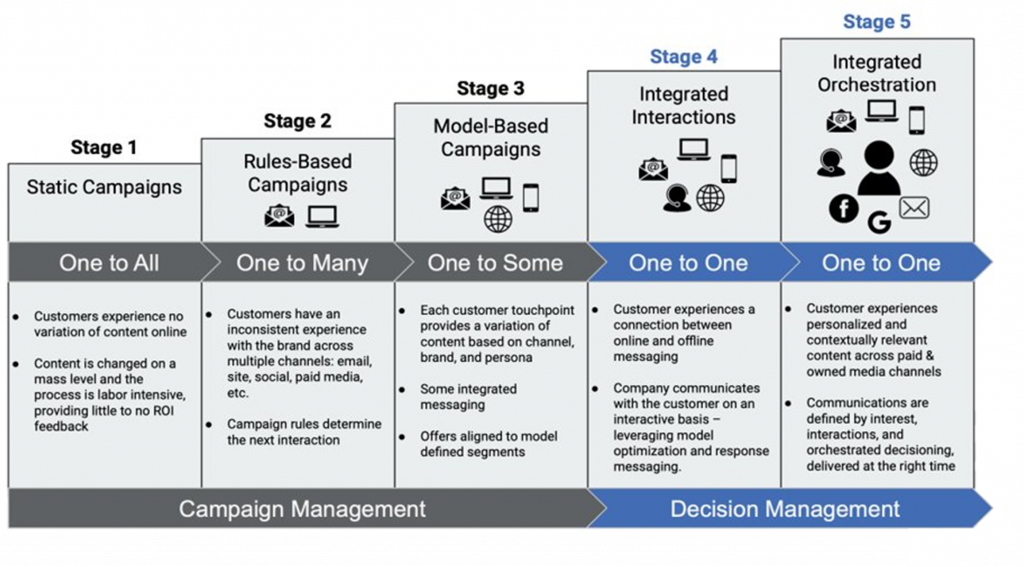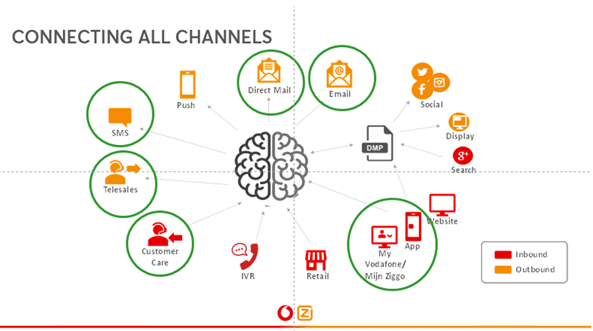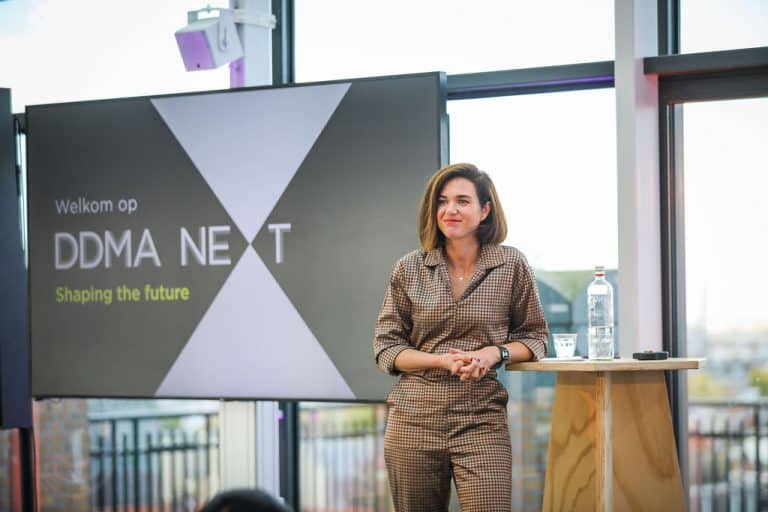This article has also been published in Dutch.
One approach to tackling the above challenges is to orchestrate ‘customer journeys’. Through journey orchestration, companies aim to follow consumers through their journey to ‘conversion’ and make it as personalised and relevant as possible. A conversion can be a purchase, but can also consist of softer metrics, such as filling out a form. In this article, we discuss the previously researched added value of journey orchestration and highlight its challenges; we look a little further into the future and provide insight on how we see the role of journeys and personalisation with the aim of informing organisations to enable them to truly serve consumers on a personal level.
Journey orchestration in 2021: the real-time aspect is missing
In September 2020, the Digital Marketing Transformation Committee of the Dutch industry association of data and marketing (DDMA) conducted research into journey orchestration. The concept, the added value and the challenges were discussed during an interesting Digital Talk. Here are some of the most important findings:
- The advent of journey orchestration is partly made possible by the development of DMPs & CDPs. As a result, companies are better able to recognise customers and personalise the channel in which the customer is located.
- In practice, the journeys are designed by the marketers, who mainly focus on the most frequently used channels and draw up a somewhat static sequence. There are few opportunities for customers to behave differently than the journey dictates. In other words, if the customer follows a different journey than the one that was designed, personalisation is disappointing or non-existent.
- The journeys are set up manually, so it takes a lot of time to add all the possible customer journeys. This makes it difficult to scale up this approach.
- These devised journeys are often not personal; the journeys are focused on audiences who are expected to walk through the journey, according to the channels indicated. Everyone in this audience receives the same advertisement or email. These are therefore not tailored to the individual.
- In many cases, journeys are not real-time. Most organisations use tooling that is not able to pick up on a change in context in real time and make adjustments to content, communications or channel choice based on this.
- Content and expressions need to be designed in a dynamic way. To be truly personalised, the content needs to be dynamic, allowing it to be composed in real time. Most organisations do not yet work in this way.
We have found that journey orchestration is promising, but it is still too much based on channel and audience thinking, and lacks the real time aspect. If we, as an industry, want to take the next step in personalisation, we have to let go of designing predefined journeys. The future lies in true ‘1-to-1 customer engagement’, driven by consumers and their behaviour. Organisations need to make a shift from channel and audience thinking to putting the consumer completely at the centre and giving them more control over which message is relevant to them, at the time and in the channel of their preference.
Personal interaction is a must
Research by Forrester shows that consumers not only expect a personal interaction but that it is even considered negative if organisations cannot deliver this. To gain a customer’s loyalty, an organisation must be able to add value to the consumer’s life, which requires a hyper-personal approach. Consumers expect organisations to listen to all the interactions and information they have provided, and to use it efficiently for relevant and personal communication.
Of course, this is easier said than done, as we notice in practice. Recent developments in the digital landscape have made it even more difficult. Most organisations make extensive use of third-party cookies. These cookies not only allow us to measure the effect of our campaigns, but also to personalise websites and advertisements and enrich customer profiles. Important elements for communicating personally with our prospects and customers.
It will not be news to many people now, but this is about to change. Browsers such as Firefox & Safari have already been blocking third-party cookies for some time, and Google Chrome will follow in 2022. *(update; Google announced June 2021 that this is being pushed out to 2023) The world of cookies as we know it today will therefore soon change completely, with a renewed focus on first-party customer data. Many different ‘solutions’ are being suggested for the future, but everyone agrees that organisations with a lot of first party data are in a strong(er) position. The data provided by the customer will become more valuable, and organisations will have to focus on this when third-party cookies are no longer available. This brings new challenges for many organisations; for example how to collect this data, or how to use it correctly in order to communicate with consumers in a relevant and personal way.
Where do we go from here?
In order to implement a true 1-to-1 customer engagement strategy across channels, most organisations will need to seek help from tech companies who can help construct this in an automated manner. The manual element is going out: machine learning and the use of AI models are becoming the new norm.
To be relevant to the customer in real time, an organisation needs technology that captures customer behaviour, analyses it, and can select the most helpful follow-up response. That follow-up may sometimes consist of a relevant sales message; at other times it may consist of sending a more appropriate service message. On the one hand, we have more and more technology and tooling at our disposal, which allows for real-time personalisation; on the other hand, we face more and more challenges in recognising our customers. So where do we go from here?
Start at the beginning and, as far as we are concerned, that means getting your first party data in order. The data that your customers have entrusted to you is extremely valuable and will only become more so. Make sure this data is up to date and available to the marketers who work with it. Make it clear to your customers why you are asking for specific data and what they can expect from you in terms of customer experience when they give their consent. “In exchange for your consent/data, we, as an organisation, will give you X in return.”
The solution: 1-to-1 customer engagement
The 1-to-1 customer engagement approach calls for a different way of thinking when it comes to managing campaigns. With campaigns, you think as a marketer about which message you will position in which channel, completely under your own control. In 1-to-1 customer engagement, an algorithm determines your channels and what the final message will be. It therefore moves from ‘campaign management’ to ‘decision management’, as illustrated by Merkle’s Maturity Continuum below.

The marketer inputs (among other things) the decision rules and prepares the different aspects of the message, but ultimately it is a model that determines for each consumer, which message to trigger, when, and on which channel. In other words, as a marketer you are, in a sense, surrendering part of the control. This comes with its own set of challenges:
- Flexibility of your channels and content: Making 1:1 customer engagement technically possible requires a different way of thinking and designing with regards to your channels. It must be made possible to dynamically fill both the content in your media and the positions on your channels. Next to this, it is required for the content to be made available in separated ‘building blocks’, so that the individual determines when, where and how these are put together to form the final advertisement. This calls for a central content hub for creation and distribution towards outbound channels.
- Measurability of results: Dynamic design of channels and content is a crucial part of 1:1 customer engagement, and comes with challenges in terms of measurability. Which content combinations work? Which channels work? And which combinations produce the best results?
- Data privacy: This raises questions such as which data can and do you want to use to become truly personal? How do you make customers aware of the data they are sharing, and what alternative do you offer when customers do not want to share data? Organisations have a responsibility to be transparent about what data they use and how they obtain it. The requesting, recording and invoking of user permission for the use of (categories of) data must be properly organised.
1-1 customer engagement at VodafoneZiggo
If, as an organisation, you want to remain relevant in the lives of consumers it is important, as a marketer, to follow the path to 1-to-1 customer engagement one step at a time. One organisation that has been doing this for a number of years is VodafoneZiggo. We spoke with Nicole Verburg – Director of Customer Value Management – to learn more about VodafoneZiggo’s experiences and approach.
Business case
Following the joint venture between Vodafone and Ziggo, the organisation is now able to offer both mobile and cable services to consumers. With 4 million customers using fixed services and 5 million mobile customers, VodafoneZiggo is a very successful provider for about half of the Netherlands. As a provider with many customers and a lot of data, it quickly realised that a logical ‘path’ to the desired conversion was a thing of the past. However, VodafoneZiggo’s tech stack at the time limited the organisation’s ability to combine inbound and outbound marketing activities and to target customers in a personalised manner to meet their expectations.
For that reason, VodafoneZiggo launched a new project in 2018 with the aim of establishing an Always-on Marketing approach; the ability to personally approach customers at the right time, with a relevant message, on the right channel and in real time. This project is called ‘GURU’, named after a person who can make intelligent and empathetic decisions. It comes with the short but powerful tagline ‘Make sense, add value’ – ‘for both the customer and the organisation’.
The Technology
For this project, VodafoneZiggo went in search of a technology partner who could make this happen. After an RFP process, they opted for the PEGA Customer Decision Hub (CDH) – which at the time was still called ‘Pega Marketing’.
This technology can be described as a central ‘always-on’ brain, which sits at the heart of the service, marketing and sales channels. The brain is powered by AI, predictive and adaptive models, it listens and reacts in real time to customer signals where a next-best-action is required, at an individual level. The brain functions on 1st party data and is therefore not dependent on 3rd party data. The notion is that organisations should always have a 360-degree view of their customers so that they can optimally serve them, and be able to only send out messages that are personal and relevant.
Pega CDH is used at VodafoneZiggo to integrate inbound and outbound channels, including call centres, web, mobile and the campaign management programme. In the future, these will be joined by (among other things) the retail stores and the IVR channel (see illustration – the channels already integrated are shown in green). VodafoneZiggo uses this technology to monitor customer signals and interactions, and to determine which of these interactions require a response. If a response is desirable, it is personalised in real time and delivered at the preferred time via the preferred channel. This makes it possible for VodafoneZiggo to deliver a best-in-class customer experience in the near future.

Approach
In the case of VodafoneZiggo, we worked locally with the agency Merkle and a number of external business consultants to give structure to the implementation of the project. A crucial part of the roll-out was a clear owner and a Centre of Excellence (COE) team that would lead the project. Under Nicole Verburg’s care, this team consists of existing employees with varying skill-sets, but all with an affinity for technology; martech, technical support, data analysts, and project managers. The marketers responsible for the below-the-line channels have come together in the Marketing Tribe. The COE forms a group of GURU ambassadors, who are the enablers for the internal marketing teams. In order to present the project across the organisation, Nicole Verburg introduced GURU to some 3000 employees during an all-hands meeting, with the support of the CEO & CCO.
Implementation
After setting up the organisation and determining the governance and key stakeholders, both internal and external, a detailed business case was designed. In this, the company analysed the potential added value per channel, which was followed by the decision to start with the call centre. Since technology learns from interactions, the digital channels were connected shortly afterwards, as these hold most interactions.
Vodafone employees who were already used to working with legacy tools were retrained to work with Pega, and Ziggo call centre employees have followed training courses in recent years to get up to speed.
Challenges
- It was quite an undertaking to get the whole organisation ‘on board’ with this way of thinking. But GURU has really helped to make data – both data availability and permissions – be seen as important by an ever-growing group of colleagues. Nicole Verburg: “Identifying the data sources and the availability of our customer database has ensured that we are now this data-oriented, and that awareness has grown enormously within the entire organisation.”
- The KPIs used to measure performance are directly linked to the goals formulated for each marketing squad. Squads set up multiple use cases to achieve these goals. This may not be a new approach, but the personalisation KPIs may differ from the traditional KPIs that people are familiar with. Take the call centre, for example; the KPIs here are ‘usage’ and ‘optimisation’. For the messages that are prepared for the outbound channels, it is calculated which percentage of these contributed to the monthly sales.
- The transition from the ‘migration’ phase – in which the implementation and adoption of the technology is key – to business as usual. In this phase, the aim is that the internal teams should continue the project independently with less hands-on support from the COE. The squads will soon have to analyse the results, per treatment and per channel, themselves. And to use these insights to sharpen propositions or add data sources.
Roadmap
During this project, VodafoneZiggo mainly focuses on personalising commercial and service-oriented customer communications. The process-oriented communication that is triggered when someone has just taken out a subscription, for example, is not yet on the roadmap. It was decided at the start of the project that the commercial and service-oriented customer actions would first be transferred to Pega CDH, because it is ultimately a customer tool. In addition to the messages being prepared, all channels where customer contact takes place have therefore been added to the roadmap. This is really a ‘living’ roadmap, Nicole mentions, with ‘moving panels’ because it is impossible to plan everything precisely.
Current Status: VodafoneZiggo is currently in the 2nd quarter of the 4th year, of the 5-year programme. To date 9 channels are live, 300+ messages have been made available, and tens of millions of personalised impressions are being served (mainly on the digital channels). They are in the midst of transition from the adoption to the business-as-usual phase, and monthly discussions are taking place with key squads to determine which channels and use cases are next on the roadmap. They constantly seek out the best next steps to achieve the goal of integrating all channels and offering a fully personalised experience to customers.
To close, some key takeaways shared by Nicole for marketers who are now at the beginning of a similar journey:
- Get informed; find out who the vendors are and talk to tech parties or agencies. Explore which organisations have already done this well, or who are actively working on it, and engage with them.
- Do a martech/IT assessment of your organisation and the people you have in-house. Do you have the right people in-house, or is retraining necessary? Do you want key specialists in-house? Or do you want to use external specialists?
- Call it what it is; this is a business Not just an IT or marketing project, but an organisation-wide project. Many different disciplines and departments are involved. It can only become a success if everyone starts thinking in the same way. Create and encourage that data obsession.
- It is important to get the C-suite/ senior management on board. They ought to be active supporters of the project.
- Involve stakeholders when defining the objectives and how you want to set up the team, this helps create involvement.
- Create awareness; review how you can best utilize various internal channels to tell people about the project.
1-to1 customer engagement is the future
The shift to the 1-to-1 customer engagement strategy to really put the customer first is indispensable, and will be top of the list for many organisations in the coming years. It is the future for organisations, and a great opportunity for marketers to take the lead and guide the rest of the organisation in this transformation.
Sources:
Forrester, Evolve Now To Personalization 2.0: Individualization
Forrester, Use Personalization To Drive Loyalty And Customer Obsession
Ook interessant

Media Effectiviteits Meting (MEM): Essentieel voor Efficiënte Groei

Gen-Z kijkt anders, praat anders, werkt anders




